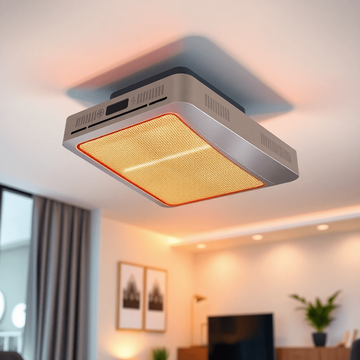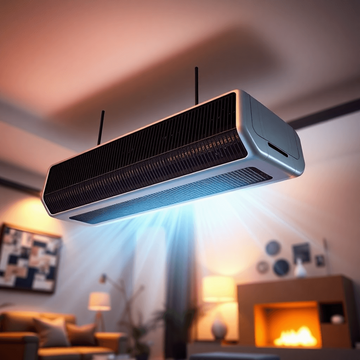Is Infrared Heating Safe?
Is Infrared Heating Safe?
Infrared heating is an energy-efficient and safe alternative to traditional heating methods. This article delves into the safety of infrared heat, safety guidelines, and the benefits of using these systems.
Understanding Infrared Heating
Infrared heating is an energy-efficient alternative to traditional heating systems, primarily by emitting infrared rays. These waves are a type of radiation emitted by the sun and are safe for human exposure when used correctly. They provide even warmth throughout rooms while being safer than conventional heaters due to their targeted approach. Alongside safety and comfort, many homeowners also consider running costs, which we explain in our guide on how much infrared heating costs to run in the UK.
Potential Risks Associated with Near-Infrared
NIR is more powerful and penetrates deeper than far-infrared radiation. Industrial settings often utilise high-powered heat sources, which emit near-infrared radiation. Prolonged exposure to NIR without proper protection can pose risks such as burns or damage to sensitive tissues like eyes. In these specific applications, protective eyewear should be worn to minimise any potential harm caused by NIR.
Why Far-Infrared Heat Is Considered Safer
Far-infrared heat, on the other hand, is considered much safer for human use due to its lower intensity level compared to NIR. Most domestic and commercial infrared heaters emit FIR rather than NIR – making them entirely safe for humans when properly installed by professional electricians who follow appropriate operating procedures outlined by manufacturers.
FIR has been shown not only as a completely safe form of radiation but also offers various health benefits such as improved blood circulation, relaxation of muscles, and pain relief from conditions like arthritis. Furthermore, since FIR heats objects directly instead of warming up surrounding air first – there’s less risk associated with flammable objects accidentally coming into contact with heaters during operation.
See Also:
The difference between Far and Near infrared
Are Infrared Heaters Safe for Pets and Children? Safety Considerations
Parents and pet owners often wonder whether infrared heaters are safe for their loved ones. Modern infrared heaters are designed with safety in mind, incorporating features to prevent burns and accidents. This article addresses common safety concerns and offers tips for safe usage.
Safe Design Features
-
Cool‑Touch Surfaces: Many panel heaters remain cool to the touch, reducing burn risk.
-
Overheat Protection: Built‑in sensors automatically shut off the heater if it gets too hot.
Placement Tips
• Wall‑Mount for Security: Wall‑mounted panels are out of reach of children and pets.
• Cord Management: Secure electrical cords to prevent tripping or chewing.
• Avoid High‑Traffic Areas: Keep portable heaters away from play areas and paths.
Educating the Household
Teach children not to play with any heater. For pets, monitor their behaviour initially; some may be attracted to the warm surface. Use barriers if necessary to prevent direct contact.
Compliance Certifications & Standards
Ensure your infrared heater meets safety standards:
- CE/UKCA Marking: Indicates compliance with EU health, safety, and environmental protection standards.
- RoHS Directive: Ensures the product is free from hazardous materials.
ROHS Directive for consumer safety
The Restriction of Hazardous Substances (RoHS) Directive further enhances consumer well-being by restricting hazardous materials usage within electrical/electronic products sold across EU countries. This directive aims at reducing environmental impact from electronic waste disposal while also protecting consumers from exposure to potentially harmful substances like lead, mercury, cadmium among others found in certain electronics.
By choosing our infrared heating panels that comply with the RoHS Directive and CE/UKCA, you can be confident in their safety and environmental responsibility.
Eye Health Concerns with Infrared Heating
One common concern about infrared heating is its potential impact on eye health, as it uses invisible electromagnetic fields (EMF). However, there have been no studies showing any negative health impacts related to this form of EMF exposure. It’s important to note that the risk associated with near-infrared (NIR) can be mitigated by using protective eyewear in specific applications where necessary.
Addressing Common Misconceptions Regarding Eye Damage
Infrared heaters emit far-infrared radiation (FIR), which is a safe and natural part of the electromagnetic spectrum. FIR does not possess the energy to alter atoms or molecules, thus it cannot harm human tissue like UV radiation can. Although FIR from infrared heaters is generally considered safe, prolonged exposure to UV radiation emitted by the sun has been linked to eye damage such as cataracts.
The use of FIR-emitting infrared heaters poses no significant risk for eye health when properly installed and used according to manufacturer guidelines. On the other hand, NIR may pose some risks if exposed without proper protection in specific industrial settings where intense NIR sources are present.
Protective Measures When Working With Near-Infrared Sources
- Eyewear: If you work in an environment with high-intensity NIR sources, wearing appropriate protective eyewear designed specifically for blocking out harmful wavelengths can help reduce your risk of eye injury due to overexposure.
- Maintain Distance: Keeping a safe distance from high-intensity NIR sources can also help protect your eyes from potential harm. Follow safety guidelines provided by the manufacturer or consult with a professional electrician to ensure proper installation and usage.
- Training: Ensure that workers who may be exposed to NIR sources receive adequate training on the potential risks associated with this type of radiation, as well as best practices for maintaining eye health and safety in these environments.
Environmental Impact:
- No Combustion: Reduces harmful by products like carbon monoxide.
- Silent Operation: No noise pollution.
- Low Maintenance: Fewer resources needed for maintenance and disposal
Check out other Environmental Benefits of Infrared Heating
Safety Tips for Using Infrared Heaters
To ensure safety, follow these guidelines:
- Keep Flammable Objects at a Safe Distance: Most manufacturers recommend a minimum clearance of 30 centimetres (12 inches) between the heater and any nearby items.
- Do Not Cover the Heater: Ensure you do not cover the heater with anything, such as clothing, as this can cause burns and marks on the heater itself.
- Install at a Safe Height: Although infrared heaters are safe around children and pets, it is better to install them at a height where they cannot be touched. Infrared heaters can reach temperatures of over 100°C, and some even up to 300°C – these come with strict instructions to mount above 2.2 meters.
FAQs in Relation to Is Infrared Heating Safe?
Is Infrared Heating Safe?
Yes, infrared heating is generally considered safe for both residential and commercial use. Far-infrared (FIR) heaters emit a gentle heat that does not cause burns or other health risks. However, it’s important to follow safety guidelines such as maintaining a safe distance from the heater and ensuring proper installation by qualified electricians.
Are Infrared Heaters Safe to Leave On Overnight?
Infrared heaters can be safely left on overnight if they are properly installed and used according to manufacturer recommendations. Make sure your heater has an automatic shut-off feature in case of overheating or tipping over, and regularly test smoke alarms in your home or workplace for added safety.
What Are the Disadvantages of Infrared Heating?
Some disadvantages of infrared heating include limited coverage area compared to traditional central heating systems, potential eye strain from near-infrared (NIR) sources if directly exposed for extended periods, and higher upfront costs for purchasing panels. However, energy efficiency benefits often outweigh these drawbacks over time.
Is Infrared Radiant Heat Safe?
Infrared radiant heat is generally considered safe when using far-infrared (FIR) technology which emits gentle warmth without causing burns or discomfort. Proper installation by professionals ensures maximum safety while enjoying the energy-efficient benefits of this alternative heating solution.
Conclusion
After reviewing the safety guidelines, eye health concerns, compliance certifications, and energy efficiency benefits of infrared heating technology, it is clear that when used properly and installed by qualified professionals, infrared heating is a safe and effective way to heat your home or workplace. Maintaining a safe distance between objects and the heater, grounding electrical outlets properly, and regularly testing smoke alarms in your home or workplace are all important steps you can take to ensure maximum safety.
Additionally, consulting with manufacturer representatives before purchasing an infrared heating system and ensuring professional installation by qualified electricians will provide added peace of mind. With its energy-efficient properties leading to cost savings over time compared to traditional electric space heaters, it makes it an ideal choice for those looking for a more sustainable way to heat their homes or workplaces.
If you’re interested in learning more about how infrared heating technology can benefit your home or business while keeping everyone safe from harm’s way, visit Infrared Heating Supplies.
Next steps: choose the right infrared heating
Continue with one of these popular options:
- Shop All Panels, accessories & bundles.
- Wattage Calculator Get the right watts for your room.
- How Infrared Works Benefits, costs & installation.






